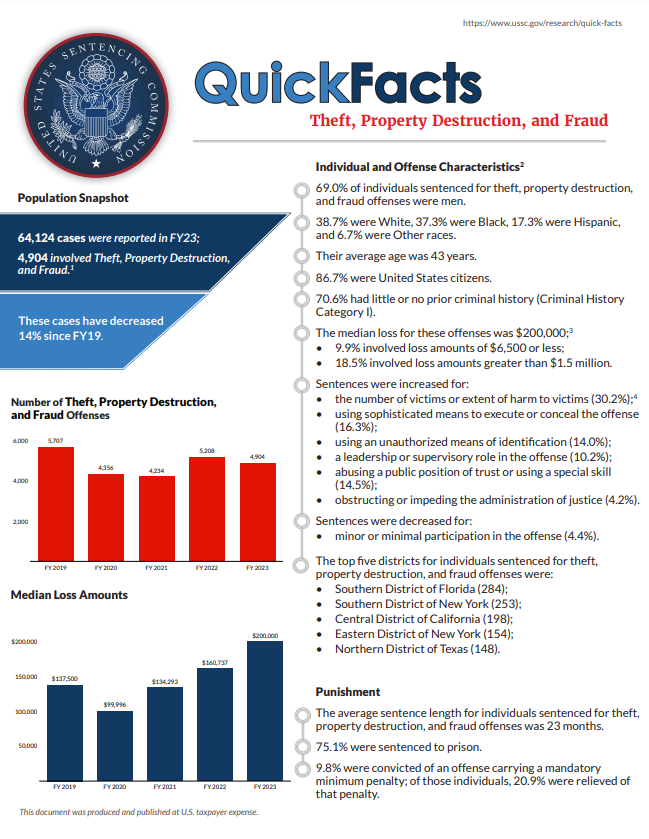Of the 61,678 cases reported to the Commission in fiscal year 2024, 5,015 involved Theft, Property Destruction, and Fraud (up 15% since FY 2020).1,2
Click the cover for the PDF handout or learn more below.
Individual and Offense Characteristics
- 70.2% of individuals sentenced for theft, property destruction, and fraud offenses were men.
- 38.6% were White, 38.6% were Black, 16.0% were Hispanic, and 6.8% were Other races.
- Their average age was 43 years.
- 88.2% were United States citizens.
- 73.0% had little or no prior criminal history (Criminal History Category I).
- The median loss for these offenses was $210,410;3
- 9.1% involved loss amounts of $6,500 or less;
- 19.6% involved loss amounts greater than $1.5 million.
- Sentences were increased for:
- the number of victims or extent of harm to victims (31.0%);4
- using sophisticated means to execute or conceal the offense (19.7%);
- using an unauthorized means of identification (14.8%);
- a leadership or supervisory role in the offense (9.9%);
- abusing a public position of trust or using a special skill (15.6%);
- obstructing or impeding the administration of justice (3.7%).
- Sentences were decreased for:
- minor or minimal participation in the offense (4.7%).
- minor or minimal participation in the offense (4.7%).
- The top five districts for individuals sentenced for theft, property destruction, and fraud offenses were:
- Southern District of Florida (272);
- Southern District of New York (232);
- Central District of California (179);
- Southern District of Texas (168);
- Middle District of Florida (145).
Punishment
- The average sentence length for individuals sentenced for theft, property destruction, and fraud offenses was 22 months.
- 74.2% were sentenced to prison.
- 8.7% were convicted of an offense carrying a mandatory minimum penalty; 17.4% of those individuals were relieved of that penalty.
Sentences Relative to the Guideline Range
- 60.1% of sentences for theft, property destruction, and fraud offenses were under the Guidelines Manual.
- 41.4% were sentenced within the guideline range.
- 14.5% were substantial assistance departures.
- The average sentence reduction was 68.1%.
- 0.1% were Early Disposition Program (EDP) departures.5
- The average sentence reduction was 30.6%.
- 3.8% were some other downward departure.
- The average sentence reduction was 55.5%.
- 0.3% were upward departures.
- The average sentence increase was 104.1%.
- The average sentence increase was 104.1%.
- 41.4% were sentenced within the guideline range.
- 39.9% of sentences for theft, property destruction, and fraud offenses were variances.
- 37.9% were downward variances.
- The average sentence reduction was 57.0%.
- The average sentence reduction was 57.0%.
- 2.0% were upward variances.
- The average sentence increase was 59.6%.
- 37.9% were downward variances.
- The average guideline minimum slightly increased while the average sentence imposed remained steady over the past five years.
- The average guideline minimum slightly increased from 28 months in fiscal year 2020 to 31 months in fiscal year 2024.
- The average sentence imposed was 21 months in fiscal year 2020 and 22 months in fiscal year 2024.
- The average guideline minimum slightly increased from 28 months in fiscal year 2020 to 31 months in fiscal year 2024.
1 Theft, Property Destruction, and Fraud offenses include cases in which the individual was sentenced under §2B1.1 (Larceny, Embezzlement, and Other Forms of Theft; Offenses Involving Stolen Property; Property Damage or Destruction; Fraud and Deceit; Forgery; Offenses Involving Altered or Counterfeit Instruments Other than Counterfeit Bearer Obligations of the United States).
2 Cases with incomplete sentencing information were excluded from the analysis.
3 The Loss Table was amended effective November 1, 2001 and November 1, 2015.
4 The Victims Table and Sophisticated Means adjustment were amended effective November 1, 2015.
5 “Early Disposition Program" (or EDP) departures are departures where the government sought a sentence below the guideline range because the defendant participated in the government’s Early Disposition Program, through which cases are resolved in an expedited manner. See USSG §5K3.1.
SOURCE: United States Sentencing Commission, FY 2020 through FY 2024 Datafiles, USSCFY20-USSCFY24.

